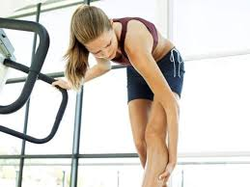
Leaving aside the third reason, let’s analyze the first two reasons, which are by far the most common causes.
1. BAD FORM. What constitutes bad form? As a Yogilates instructor, I constantly stress proper alignment, control of momentum, limited range of motion, and performing the exercises with a minimum of unnecessary tension. Any deviation in these qualitative factors can lead to bad form and thus to injury. Above all, a participant must learn alignment principles when they are lying down, sitting, and standing. The neutral, parallel positioning of the feet, knees, hips, ribcage, spine, shoulders, neck, and head have to be shown and practiced in static positions and then gradually introduced into movement. This is why modern Pilates training which includes “functional awareness exercises” is so vital and important. It would be difficult, if not impossible, for someone to know how to hold themselves in proper alignment while performing an exercise if they had not first practiced simple articulations of the body parts to see how the movement affects their alignment. Cues such as “pull your ribs in”, “draw your shoulder blades down”, “keep your pelvis in neutral”, are common in Pilates training, but would be difficult for a non-Pilates exerciser to grasp while in the middle of doing a conventional exercise against resistance. A certain amount of body awareness training is essential to insure that a person first knows what proper alignment is and then how to maintain it. Emphasis on this when training should be paramount if someone wants to avoid injury.
Other factors that constitute bad form include giving into momentum where it throws the body off its center. One cannot move without generating momentum, but it can be controlled through stabilization and by initiating the movement from the center. Again, this is part of Pilates training, but as a concept it can be practiced in any exercise or movement. Suffice it to say that if you are jerking or swinging wildly in your movement, your risk of injury skyrockets.
Other key factors I mentioned earlier that relate to injury prevention is to limit one’s range of motion(ROM). Recently, I have seen a lot of people doing an exercise that some call “Bulgarian Lunges”, which is a lunge with the back leg and foot up on a bench or step. This creates an excessive ROM for the hip flexor of the back leg and very often can lead to injury in that hip. There is a better way to accomplish the same ends without risking the strain on the back leg hip flexor. Focus on keeping your hips level and inline with your back, and simply ease up the muscles in the back leg to place more focus on using the front leg. This is what we do in the Pilates studio when we do Step Ups on the Wunda Chair. By not letting the client tilt forward at the waist, we keep the weight centered over the front leg and get more work for those muscles.
Lastly, holding unnecessary tension anywhere in the body while exercising can lead to a strain. Always take a “sigh” exhale before beginning an exercise and try to let go of any unnecessary tension in the body. Try to get to know your tension spots, the places you usually grip, like the neck or shoulders, or buttocks or feet. If you can relax before and breathe with your movements, you will more likely be working with your body, rather than against it.
2) NOT SUFFICIENTLY PREPARED. It sounds so common sense, but you would be surprised how often this is the reason why people get injured. It is the classic weekend warrior syndrome – doesn’t exercise all week, then goes out and plays hard on the weekend and gets injured. To be truly effective, and to reduce the risk of injury, training needs to be consistent, progressive, and balanced. Someone who hasn’t run in months (or years) can’t suddenly go out and run like they used too just because they decide they are going to do it. Just like it would be silly to try to lift something too heavy for you, the same is true with trying to do an aerobic activity at an intensity level (speed) or duration that you are not used to. Same thing applies with flexibility exercises. Someone who hasn’t done any stretching for years and then goes into a power yoga class is setting themselves up for a strained, even a pulled muscle. For most people who are deconditioned and want to start exercising it is recommended to start with simple, functional strength, balance, and flexibility exercises. Simple exercises that are fully doable are better than complex movements even if your eventual goal is to play a sport that involves plyometric and/or coordinated movements. To better prepare for sports, one would be best served by doing body-weight exercises that teach not only strength, but work on stability and engaging of supportive core muscles, such as push-ups, free squats, supported lunges, and general calisthenics. Most people as they get older get better at pacing themselves and can perform well at moderate aerobic activity for extended durations. Unfortunately, our joints and tendons can become stiffer as we age, and support muscles can become weaker so while we may not feel pain during the workout, we often experience pain afterwards that gradually increases with each consecutive workout. The best ways to prevent this is 1) Always do a thorough warm-up before exercising which should include some gentle dynamic movements like leg and arm swings, brisk walking, short/light repetitions of planned exercises, etc. 2) Set a reasonable goal for each workout. You have to start from where you are. Anything that is new, or you haven’t done in a long while, needs to be approached carefully and performed at moderate intensity and duration so that the body can gradually get used to it.
So, let’s all take some time to be sensible in our workouts. Never sacrifice good form for more intensity. Be gradual in your planning and be consistent in your schedule. Here’s hoping that the exercising you choose, and the way you do it, makes you healthier and injury free for the long term.


 RSS Feed
RSS Feed
